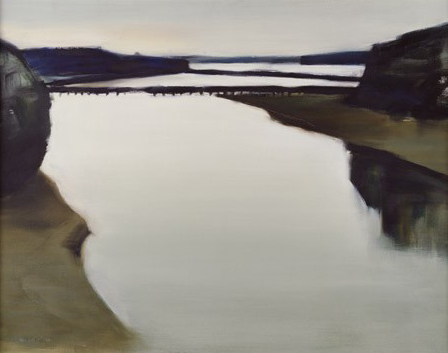Helen Campbell Brown lived all her life in Tāmaki Makaurau. For a period of eight years in the late 1930s and early 1940s, she took evening classes at Elam School of Art, while employed at the Banks Box Company as a packaging designer. Her teachers included the school’s principal, A. J. C. Fisher, and the well-known painter John Weeks. She often went with other pupils of Weeks’s on painting holidays in the King Country where they all specialised in the production of sombre hilly landscapes devoid of human subjects. Like Vida Steinert, Frances Hunt, Jack Crippen, Blanche Hazelwood, and others in the group, Brown’s work gradually began to display the particular brand of soft Cubism with which all Weeks students experimented as a means of achieving a more modern conception of form than was practised by painters like Ida Eise, who also taught at Elam. So pervasive was Weeks’ influence on his pupils at this time that in later years Helen Brown and Vida Steinert were quite unable to distinguish between each other’s work.
Weeks also encouraged his students to paint urban scenes in Grafton and Ponsonby. These usually displayed a rather grim urban realism far removed from the nostalgic neo-romanticism associated with the dilapidated rural cottages depicted by artists like Eric Lee-Johnson. For a period between 1944 and 1950, such urban scenes formed the basis of Brown’s work exhibited with the Rutland Group, an association of Weeks pupils. Members attracted favourable critical attention as the result of their efforts to dissociate themselves from conventional landscape painting shown at Auckland Society of Arts exhibitions. In 1951, Helen Brown spent a year in Europe. She was so overwhelmed by what she saw that she gave up painting altogether for one year upon returning to Tāmaki Makaurau. The unpublished letters she wrote to Weeks from Europe are a fascinating record of her thoughts and feelings during this time. After she had assimilated her overseas experience, her art took on a new vigour; her landscapes became bolder in design and more adventurous in colour.
During the period 1961 to 1974, when her work was at its peak, Brown regularly exhibited at the John Leech Gallery. In her 1961 show, she changed direction, showing thinly painted shimmering images of estuaries, headlands, and islands in the Kawau-Mahurangi area north of Auckland. From 1961, she single-mindedly turned her attention to the headlands and quiet stretches of water of the Hauraki Gulf, drastically cooling her palette (disliking bright colours, she never painted in summer and only rarely on sunny days), and pursuing a geometric structural rigour that took her far beyond anything imagined by Weeks. Her Auckland Harbour is considered a masterpiece.




